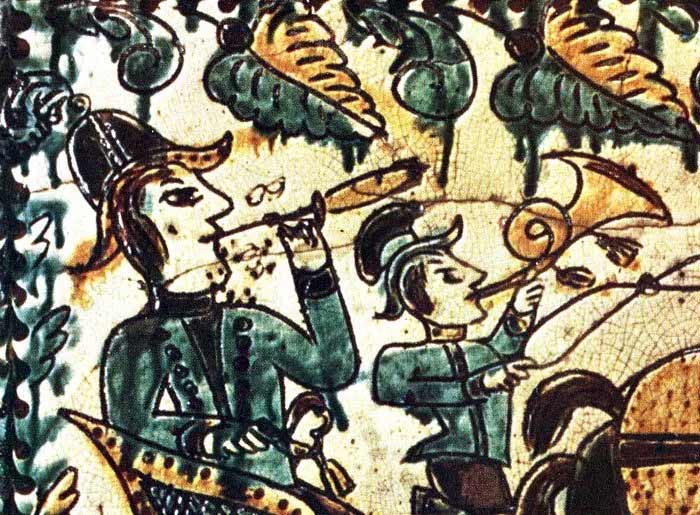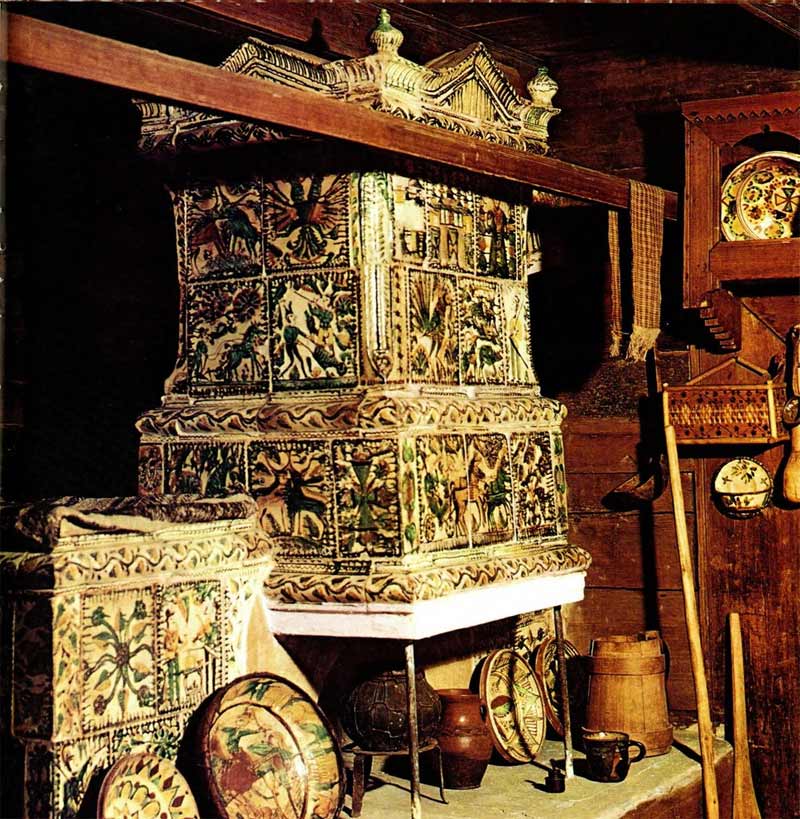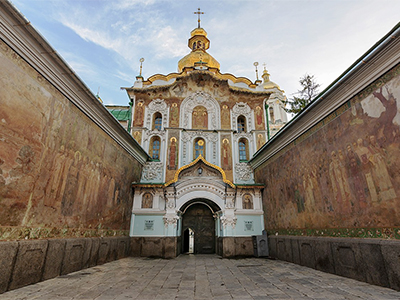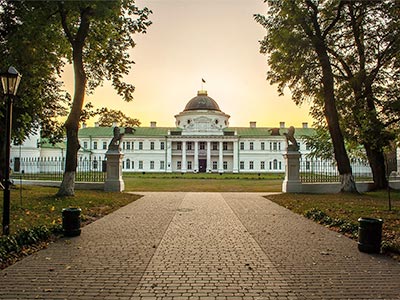 27.07.2018
Kosiv stove
27.07.2018
Kosiv stoveHutsul life has always been rough and hard, but surrounded by amazingly beautiful landscapes. Arts and crafts of Ukrainian Carpathians are closely connected with this difficult life style; it reflects this mountainous aesthetic and distinguishes with vivid originality. Among the variety of its aspects, pottery is considered the most laborious and capricious craft. And tile manufacture is a special kind of it.
The most complete collection of Hutsul tiles is assembled in Kolomyya Folk Museum of Hutsulshchyna and Pokuttia (20 Teatralna Street, Kolomyya) and is fitted into the rich Hutsul interior of the late XIX – early XX centuries. The interior is virtually ultimate in its completeness and perfection – with the stove made of tiles by Oleksa Bakhmatyuk (1829-1882), the most distinguished ceramist of Hutsul region, also known under the name Bakhminskyi.
Kosiv stove and Hutsul tiles. How it is made
An order of the laid tiles has a clearly stated rhythm accented with the original crown from the frontons and the corner adornment above the chimney. The painted tiles were obligatorily laid from the top to the bottom according to the importance of the themes. The first row from the top is, of course, the most important. It was considered a talisman; it was turned to with different requests. On both sides there were tiles with the religious themes, the themes of social or national importance, for example, featuring the bells, the Austrian double-headed eagle. The images of everyday scenes – a farmer with cradles, hunters which went hunting- were laid on the right and on the left… And here, by the way, you have an example of Hutsul humor – a hunter carries another on a wheelbarrow, while the one being carried shoots a bird.
The painted tiles were obligatorily laid from the top to the bottom according to the importance of the themes.
In the second row of the stove there were tiles with the images of the things, which gave the opportunity to live in difficult mountainous conditions. It always was a lamb, which gave clothes, warmth and food. Musicians were often impictured on the stove tiles; they plaid the violin, silica and rarely – trembita. Hutsuls would not be Hutsuls, if ornamenting tiles would not mention the consequences of a visit to taverna – a husband came home, and a wife waited with a hatchet in hand, showing who was a head…
Oleksa Bakhmatyuk – a son of a potter – adopted elements of craft from his father, with whom he lived in Old Kosiv, and studied painting by the young but already famous Petro Baraniuk. He did not only set out the themes existing before, enriching them with interesting details, but also performed many new things, creating in such a manner an amazing tale about the life in the mountains. His Hutsul with a pipe in his mouth carries a pig on a wheelbarrow; his hunter shoots a bird which dabs a roof of a two-storey manor house. His master (because of boots) or Hutsul (because of the mustache) plows with two horses, and large sunflowers bloom over their heads. Bakhmatyuk’s two soldiers point guns at each other and between them there is a house with their shoulders high.
Emperor Franz Joseph, having seen the samples of Kosiv stove in Kolomyya Industrial Exhibition in 1880, ordered a painted stove, which was soon made and sent to Vienna
Oleksa Bakhmatyuk’s works were exhibited, attracted constant interest and admiration. The researcher David Hoberman describes in his book “Hutsulshchyna – a land of art” a case where Emperor Franz Joseph, having seen the samples of Bakhmatyuk’s tiles in Kolomyya Industrial Exhibition in 1880, ordered a painted stove, which was soon made and sent to Vienna. At the same exhibition Oleksa received a gold award.
His talent was original and unique which is said about as follows – a gift from God. You will never more find such lively vision and filling of the world, such vital dynamics and will for life, such grotesque and irony, such broad flight of imagination and fantasy, multiplied by the incredible variety of themes and designs.
Kosiv ceramic school

Famous Kosiv stove
Oleksa Bakhmatiuk’s art had a great influence on the artists of the next generation. The most famous of them are Mykhailo and Yosyp Baraniuks. Together with Bakhmatyuk they represent Kosiv ceramic school. And in the village Pistyn near Kosiv, a school was founded, which is associated with the dynasty of three generations of Zintiuks, and especially with the oldest of them – Dmytro. His works are characterized by contrasts, oppositions and hiperbolicity of forms; strength and constructability of compositions are felt in them. Dmytro Zintiuk used a particular kind of floral motifs – branches in the form of huge ears, large leaves, and flowers in the form of rings. Kosiv and Pistyn designated the main features of Hutsul ceramics. Although their masters used the known technique – engraving succeeded by glazing – each of them had his secrets, his technology of burning, not to mention the idiom, which was presented in the nuances of colors and shades, variety of geometric and plant motifs, originality of composition and regularity of lines and shapes.
Because the masters worked apart, employing mainly family members, the works of the potters were mostly anonymous
But because the masters worked apart, employing mainly family members, the works of the potters were mostly anonymous, except Oleksa Bakhmatiuk, Petro Koshak and some others who signed their work. Art critics still argue about the belonging of certain works to a particular master…
Kolomyya ceramic school
Our story would be incomplete without reference of Kolomyya ceramics, which has its own express identity. The oldest tiles survived in great numbers are certainly from Kolomyya. Firstly, there were deposits of the best clay exactly in this region. Secondly, the city was opened for travels and travelers, and had its original cultural environment.
Kolomyya school has its own style of painting, another technique (so-called “fliandrovka”), and technology. There is a family of Kakhnikevych – the father Mykhailo Fedorovych was a great technologist. He poured just out his pottery from the bag on the ground; they fell, jingled and did not break.
In general, in the late nineteenth century more than 100 potters worked in Hutsul region. They supplied their products not only in all mountain villages, but also in Galicia and Bukovyna, many works got into the neighboring countries – Romania and Poland. But over time, the individual tile pottery declined, giving place to industrial workshops.Nowadays, we can forget about revival of this kind of folk art. Although in Kolomyya and outside there are families of great masters dealing with ceramics, they make stoves to order, which are copies of the famous works or original author’s works. In Kolomyia region, graduates of Kosiv College of Applied and Decorative Arts named V.Kasiian opened a small factory for manufacture of fireplaces and stoves. But, of course, this is not about previous extent and it is difficult to find customers. That is they make only decorative souvenir things, which look very nice even just immured in a wall.
Do Hutsul tiles have a future?
There are many people who like folk art, but those who have its models in their houses are very few. Currently, these decorative tiles are bought only by polish tourists, for whom this art is familiar. Taken as a whole, foreign visitors take souvenir dolls, as it turns out, they heard about them many times, and about tiles – didn’t.
Authentic tiles come up not very often
A collector from Kolomyya Ivan Vyshyvaniuk agrees with the idea that we promote our heritage in the world insufficiently. He has engaged in collecting for six years and is confident that Hutsul tiles would be exhibited at the most prestigious world auctions. If somebody knows about Kosiv ceramics, about Kolomyia – nobody.
According to him, authentic tiles come up not vary often, but he managed to gather a collection of purely Kolomyya ceramics. Also, Mr. Ivan showed us his two most recent acquisitions and dispelled sadness that in Hutsul region there was no authentic tiled stove of local artists left. He says he knows at least five houses with the stoves. But it is difficult to say how long they will survive there.
-
 27.02.2024
World of pysanka
Embark on a journey into the captivating world of Pysanka, the Ukrainian...
27.02.2024
World of pysanka
Embark on a journey into the captivating world of Pysanka, the Ukrainian...
-
 29.01.2024
Exploring the Treasures of Kyiv’s Lavra Monastery
In the heart of Kyiv lies the venerable Lavra Monastery, a testament...
29.01.2024
Exploring the Treasures of Kyiv’s Lavra Monastery
In the heart of Kyiv lies the venerable Lavra Monastery, a testament...
-
 13.01.2024
Kachanivka, Eden on Earth
Rich in history, it hosted renowned artists, notably poet Taras Shevchenko.
13.01.2024
Kachanivka, Eden on Earth
Rich in history, it hosted renowned artists, notably poet Taras Shevchenko.

